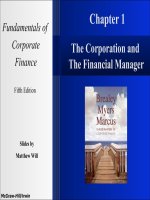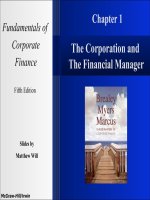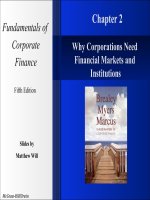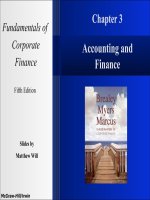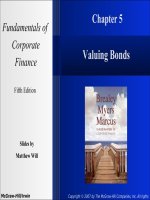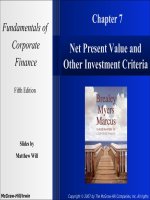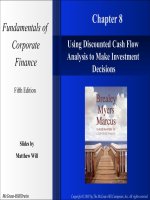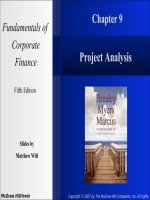Fundamentals of corporate finance 10e ROSS JORDAN chap016
Bạn đang xem bản rút gọn của tài liệu. Xem và tải ngay bản đầy đủ của tài liệu tại đây (1.47 MB, 87 trang )
Chapter
16
Financial Leverage and Capital
Structure Policy
16-1
McGraw-Hill/Irwin
Copyright © 2013 by The McGraw-Hill Companies, Inc. All rights reserved.
Chapter Outline
•The Capital Structure Question
•The Effect of Financial Leverage
•Capital Structure and EBIT
•M&M Propositions I and II with Corporate
Taxes
•Bankruptcy Costs
16-2
Chapter Outline
(continued)
• The Optimal Capital Structure
• The Pie Again
• The Pecking-Order Theory
• Observed Capital Structures
• A Quick Look at the Bankruptcy Process
16-3
Chapter Outline
• The Capital Structure Question
• The Effect of Financial Leverage
• Capital Structure and EBIT
• M&M Propositions I and II with
Corporate Taxes
• Bankruptcy Costs
16-4
Capital Restructuring
Definition:
Capital Structure is the amount
of debt and the amount of
equity a firm uses as its sources
of capital.
16-5
Capital Restructuring
Definition:
Leverage is the use of financial debt.
The concept of leverage is just like that in
physics where a small change in one thing
has a big effect in another thing.
16-6
Capital Restructuring
We are going to look at how
changes in capital structure
impact the value of the firm,
all else equal.
Capital restructuring involves
changing the amount of leverage a
firm has without changing the
firm’s assets.
16-7
Capital Restructuring
The firm can increase leverage by
issuing debt and/or repurchasing
outstanding shares
The firm can decrease leverage by
issuing new shares and/or retiring
outstanding debt
16-8
Choosing a Capital
Structure
What is the primary goal of financial
managers?
Maximize stockholder wealth!
We want to choose the capital
structure that will maximize
stockholder wealth.
16-9
We can maximize stockholder wealth
by maximizing the value of the firm or
minimizing the WACC.
Chapter Outline
•The Capital Structure Question
•The Effect of Financial Leverage
•Capital Structure and EBIT
•M&M Propositions I and II with Corporate
Taxes
•Bankruptcy Costs
16-10
The Effect of Leverage
•When we increase the amount of debt financing, we
increase the fixed interest expense
•If we have a really good year, then we pay our fixed
cost and we have more left over for our
stockholders
•If we have a really bad year, we still have to pay our
fixed costs and we have less left over for our
stockholders
16-11
The Effect of Leverage
How does leverage impact the EPS and ROE
of a firm?
Leverage amplifies the variation in both EPS
and ROE. A small change in leverage
generates a large change in profits.
16-12
Example: Financial
Leverage, EPS and ROE:
Part I
(We will ignore the effect of taxes at this stage.)
What happens to EPS and ROE when we issue debt
and buy back shares of stock?
Financial Leverage Example
16-13
Example: Financial
Leverage, EPS and ROE:
Part II
Variability in ROE
Current: ROE ranges from 6% to 20%
Proposed: ROE ranges from 2% to 30%
Variability in EPS
Current: EPS ranges from $0.60 to $2.00
Proposed: EPS ranges from $0.20 to $3.00
16-14
The variability in both ROE and EPS
increases when financial leverage is
increased
Chapter Outline
• The Capital Structure Question
• The Effect of Financial Leverage
• Capital Structure and EBIT
• M&M Propositions I and II with
Corporate Taxes
• Bankruptcy Costs
16-15
Break-Even EBIT
We are trying to find the Earnings
Before Interest and Taxes (EBIT)
where the Earnings Per Share (EPS)
is the same under both the current
and proposed capital structures.
16-16
Break-Even EBIT
If we expect the EBIT to be greater than the
break-even point, then leverage may be beneficial
to our stockholders.
If we expect the EBIT to be less than the breakeven point, then leverage is detrimental to our
stockholders.
16-17
Example: Break-Even
EBIT
EBIT
EBIT − 250,000
=
500,000
250,000
500,000
( EBIT − 250,000 )
EBIT =
250,000
EBIT = 2EBIT −500,000
EBIT = $500,000
Break-even Graph
500,000
EPS =
= $1.00
500,000
16-18
Example: “Homemade”
Leverage and ROE
Current Capital Structure
Investor borrows $500 and
uses $500 of her own to buy
100 shares of stock
Payoffs:
Recession: 100(0.60) - .1(500)
= $10
Expected: 100(1.30) - .1(500) =
$80
Expansion: 100(2.00) - .1(500)
= $150
Mirrors the payoffs from
purchasing 50 shares of the
firm under the proposed
capital structure
16-19
Proposed Capital Structure
Investor buys $250 worth of
stock (25 shares) and $250
worth of bonds paying 10%.
Payoffs:
Recession: 25(.20) + .1(250) =
$30
Expected: 25(1.60) + .1(250) =
$65
Expansion: 25(3.00) + .1(250)
= $100
Mirrors the payoffs from
purchasing 50 shares under
the current capital structure
Chapter Outline
• The Capital Structure Question
• The Effect of Financial Leverage
• Capital Structure and EBIT
• M&M Propositions I and II with
Corporate Taxes
• Bankruptcy Costs
16-20
Capital Structure Theory
Modigliani and Miller (M&M) have
proposed a two-part
“Theory of Capital Structure”
Proposition I – Firm value
Proposition II – WACC
16-21
Capital Structure Theory
Proposition I – Firm value
The value of the firm is determined by
the cash flows to the firm and the risk of
the assets
The firm’s value will change due to:
1. The changing risk of the cash flows
2. The changing cash flows themselves
(amounts and timing)
16-22
Under Three Special
Cases
Case I
Case
II
Case
III
16-23
• No Corporate or personal
taxes
• No bankruptcy costs
• Corp. taxes; no personal taxes
• No bankruptcy costs
• Corp. taxes; no personal taxes
• Bankruptcy costs
Proposition I – Firm Value
Case I
Case
II
Case
III
16-24
• No Corporate or personal
taxes
• No bankruptcy costs
• Corp. taxes; no personal taxes
• No bankruptcy costs
• Corp. taxes; no personal taxes
• Bankruptcy costs
Proposition I + Case I
• The value of the firm is NOT
affected by changes in the
capital structure
• The cash flows of the firm
do not change; therefore, value
doesn’t change
16-25
